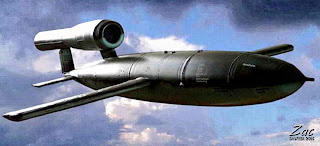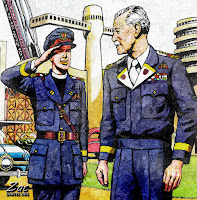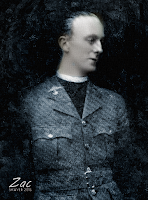 |
| Marcus Morris by Zac |
|
|
|
| | |
|
It is true that the comic was initially created by Marcus Morris and Frank Hampson.
Morris was a 'snobbish' Anglican Vicar, failed Air-force Chaplain and failed Parish 'Priest', who had dabbled in publishing with his parish magazine, 'The Anvil'.
 |
| Frank Hampson by Zac |
Hampson was a failed art student who, after leaving the Army, was desperate for work. Morris needed an illustrator for 'The Anvil', and Hampson needed a job, and so the unlikely two teamed up – by necessity rather than any shared sympathies.
However, with 'The Anvil' on its last legs, and very deeply in bebt, Morris was desperate to find another option for his obsession with becoming a magazine publisher.
And so Hampson came up with the unlikely idea of 'Dan Dare – Space Chaplain' – after all, Morris had been an Air-Force Chaplain, even if he wasn't up to the job, and in the end resigned.
Of course 'Dan Dare – Space Chaplain' never even reached even the first issue, and one wonders if the concept was ever seriously intended for publication.
In reality it appears that it was an initial subterfuge to get some into thinking that all the 'spin' about a 'Christian Comic' had some sunstance.
The 'myth' about the creation of the Eagle, of course, is that it was a riposte to the appalling American 'horror comics' which were supposedly warping the minds – and morals – of innocent little English boys.
The 'Eagle' was, supposedly, a 'Christian' comic for boys.
Now the only 'Christian' item in the Eagle was a strip featuring New Testament stories on the back page – which hardly any boys read.
Interestingly, this specifically Christian strip was not Morris' 'baby', but was included because it gave Hampson a chance to give his version of all the great images in Christian art – the Crucifixion, the Nativity, the entry into Jerusalem etc – which he did very well – (interestingly, however, Hampson is not remembered for his 'religious' images).
As for encouraging boys to live 'Christian' lives – well that's just part of the myth.
In reality Morris was a womanising, hard drinking 'money grabber', and Hampson was an obsessive monomaniac – and neither of them really cared deeply about Christian morality, although Morris gave superficial lip service to Christian values – until he became editor of 'Cosmopolitan'.
So the 'myths', as such, relate to the supposedly 'saintly' Marcus Morris, and the idea that the Eagle, as thought up by Hampson, was a boy's 'Christian comic'.
And the name ?
Well the 'myth' teeters between the traditional Anglican eagle lectern in Marcus Morris' church, and an ink-stand in the shape of an eagle in Morris's study.
 |
| RAF Woodvale by Zac |
In reality, the name and the emblem owe nothing to Christian iconography, but rather are inspired, more prosaically, but justifiably, by the nearby RAF Woodvale (on which Hampson based the Space Fleet HQ), which had an eagle as it emblem (in addition to the usual RAF eagle), and the motto 'UT AQUILAE VOLENT' -
(That Eagles May Fly) - very appropriate.
But what was the Dan Dare 'strip' in the eagle really about ?
That's a question that very few people ask.
Well, to begin with, Dan Dare had practically nothing to do with Marcus Morris.
Dan Dare was the creation, almost solely, of Frank Hampton.
Morris, of course, gave it his approval, and support, when he realised that it was a superb 'money-spinner' – and then took most of the money and the kudos for himself, depriving Hampson of even the copyright !
Hampson's obsession (and it was an obsession), with space flight seems to have been born when he was in the British Army, and came into contact with German rocketry, at the end of the war.
And so, around this obsession, he created a unique 'world' – the world of Dan Dare.
But that world is not quite so simple – or 'clean cut' - as one may imagine.
Within the stories, and the quite amazing 'art', there are trends and themes that are strange, and somewhat unlikely.
One of these themes is that of a faint 'homo-eroticism'.
HOMO-EROTICISM
So, what is homo-erotic about the work of Frank Hampson ?
Well, for one thing we are not suggesting that Hampson was homosexual.
He was married, (happily or not we do not know), and he had one son, Peter.
And one thing to clear up at this point is the connection between Peter Hampson and 'Flamer' Christopher Spry (and we will be hearing a lo more about 'Flamer' later).
According to the often quoted 'myth', 'Flamer' was based on Peter Hampson.
This is not correct.
Firstly, Peter was too young when 'Flamer's' character was first created, and secondly, there is a photograph of the boy on whom 'Flamer' was based.
However, it has not been possible to discover who the boy was - and no one who may know is telling.
To return to Frank, however, while he was probably not homosexual, he undoubtedly had homo-erotic tendencies, which can be clearly discerned in some of his illustrations (should we call it art ?), and in the characters and story-lines to be found in the adventures of Dan Dare, as featured in the 'Eagle' comic.
The obvious example, of course, is the relationship that exists between Colonel Dare and 'Flamer' Spry, a cadet from the Space Fleet Astral College.
'Astral College', in case you don't know, is a kind of space-age Eaton, with 'fagging', prefects and uniforms, and of course
no girls.
IN THE BEGINNING
We should begin, of course, at the beginning, however, with two men who each have an important place in Colonel Dare's life.
 |
| Sir Hubert Guest by Zac |
The first is his immediate boss, Sir Hubert Guest, the Space Fleet Controller.
The second is Spacemen First Class Albert (Dig) Digby.
Now the relationship between Dare and Guest is not strictly speaking 'homo-erotic'.
We know that there was a connection between Sir Hubert and Dan's father, back in the early days of space exploration - and this may help to explain how Dan became a colonel in his early twenties.
It should also be remembered that there is an age gap of approximately thirty years between the two men.
Dan's father died when Dan was still a boy, and it seems the Sir Hubert became a substitute father.
It is interesting to note, however, the despite Sir Hubert's gruff manner, and 'stiff upper lip', he appears to be inordinately, and possibly inappropriately fond of his young protégé.
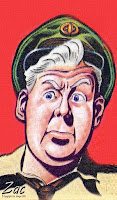 |
| Albert Digby by Zac |
Digby (Spacemen First Class Albert Digby) is a completely different case - or almost.
Like Sir Hubert, he's older than Dan, and also inordinantly fond of his young boss.
'Dig', surprisingly, is married, and has two children, although you hardly
ever see him with his family.
Even when Dan has 'leave', Dig tags along with him ('Safari in Space' - with Flamer in tow), so the two men holiday together, with Digby's wife and kids left at home.
Digby's official position is Colonel Dare's 'batman'
In case you don't know, this has nothing to do with the 'caped crusader'.
A 'batman' is a soldier or air-man assigned to a commisioned officer as a personal servant.
Before the advent of motorized transport, an officer's batman was also in charge of the officer's "bat-horse" that carried the pack saddle with his officer's kit during a campaign.
Now apparently Digby is a first class pilot, and on numerous occassion has been offered promotion, however, he prefers to stay a simple 'menial', so that he can stay with his beloved Dan.
Digby, however, also seems to have some 'connection' with young 'Flamer' as, in the 'Posiedon' and 'Galactic Galleon' they 'bunk' together.
'FLAMER' SPRY
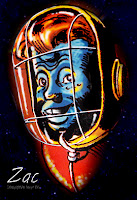 |
| Cadet Urb by Zac |
Flamer Spry is a
character who was introduced to the Dan Dare strip in the story
'Prisoners of Space'.
His precursor was Urb,
a fourteen year old blue Atlantean boy who, for some reason, never
fully explained, was serving on the space-ship that was carrying
Sondar, Dan, Digby and Professor Peabody, and which crashed on
Mercury ('Marooned on Mercury').
And like 'Flamer', Urb
had a 'shock' of red hair.
Urb, however, although a charming boy, and excessively 'polite', was blue, (he was an Venusian Atlantine), and despite Hampton's oft lauded 'anti-racialism' and supposed 'political correctness', blue was not really acceptable.
So Urb fades from the scene, to be replaced by a far more acceptable 'white' earthboy, 'Flamer'.
'Flamer', according to
information published outside the comic strip, was born in Middlesex.
He is a cadet at the
Space Fleet Astral College - that space-age Eton to which we have
previously referred..
Unlike all the other
major characters in the Dan Dare stories, nothing else is known about
this boy, other than the fact that he is aged about thirteen years
when he first meet Dan Dare in 'Prisoners of Space'.
There is, however, a
problem with young 'Flamer'.
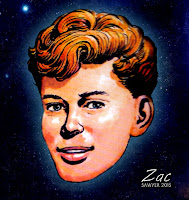 |
| Flamer Spry by Zac |
Flamer appears in both
the undersea expedition in Lex O’Malley’s submarine 'Poseidon',
and as a member of the four man Earth Expedition that is sent to the
planet Cryptos, to save the peaceful Crypts from invasion by their
war-like enemies, the Phants.
Now it seems, at the
very least, puzzling that a boy of Flamer's age should have been sent
on the Cryptos Expedition, or Poseidon exploration ?
One should remember
that he is presented as a thirteen year old boy, and while it is
possible to understand and appreciate the obvious commercial asset created by including of character, of a similar age and gender, to that of the Eagle‘s audience directly in the story, the
fact remains that Hampson never explained why this young boy
should form an essential part of so many of the Dan Dare adventures.
In a less 'realistic'
comic strip it would be easy to ignore the fact that such a young lad
is involved in such 'adventures', but Hampson has set standards of
realism, both in his art and in the construction of his stories,
that prevent one from ignoring the flaws and inconsistencies in the logic
of his world.
It was, perhaps,
permissible for Flamer to play an essential role in the story
'Prisoners of Space'.
His introduction into
that story was logical, well-planned, and the result of a perfectly
believable accident.
 |
| The Reception at the Venusian Embassy by Zac |
And it was equally
reasonable for Flamer to be present at the Embassy Reception, where
he enjoyed recognition for his part in the apparent 'defeat' of the
Mekon.
However, when the alarm
sounded, and Dan went off to deal with the problem, Flamer, quiite
rightly was not among the crew.
The fact, however, that
Lex O’Malley who, it appears, has known Dan for maybe a half hour,
does go with the interceptor squadron is strange, to say the least.
The one big question,
however, that’s never answered in all the stories in which he
appears is just who the Junior Cadet nicknamed 'Flamer' Spry is in
the first place.
And at this stage,
perhaps we should consider one of the main problems with regard to
young 'Flamer'.
He appears, apparently
out of nowhere, along with Space Fleet Astral College, and all its
cadets, Senior and Junior, in the first part of 'Prisoners of Space'.
It is not suggested
that Colonel Dare has ever heard of Cadet Spry before 'Flamer’s'
model rocket ship nearly collides with Sir Hubert, but Dan is
sufficiently impressed by the young cadet that he decides that the
only ‘punishment’ for the prank would be a tour of the real
thing.
This scenario, of
course, is perfectly plausible, and considering how well 'Flamer'
conducts himself in what are obviously difficult circumstances, it’s
possibly understandable that Dan might then look upon him as a sort
of protégé.
Taking the above into
consideration, the decision to make a place for 'Flamer' on
O'Malley's 'Poseidon' expedition, which was a non-combat,
search-and-rescue mission, is equally understandable and logical.
It is, however, the
events after the 'deep sea' expedition that seems more than unlikely,
and raises some difficult questions.
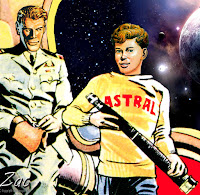 |
| 'Flamer' and Dan by Zac |
Dan has the task of
going to Cryptos to help the Crypts defend themselves against the
Phants.
The operation involves
a trip across interstellar space, with three volunteers, one of whom
is obviously going to be Digby.
'Flamer', it seems,
puts himself forward as a volunteer, and this can bee seen as an
example of unrealistic, but well intentioned boyish enthusiasm.
The odd result,
however, is that although he is only a thirteen year old boy, he is
accepted, - on an practically suicidal mission, travelling to attempt
avert war five light-years from Earth.
'Flamer', as has been
explained, is an approximately thirteen year old boy at Astral
College, - which is a full-time, military-based establishment and,
like a boarding school pupil, he lives in.
The College is,
therefore, 'in locus parentis'.
In practice, 'in locus
parentis' would mean the Headmaster, and via devolved authority, the
masters.
Ultimately, however,
the responsibility would rest with the Controller of Space-fleet, Sir
Hubert Guest, who is also the supreme authority on Dare’s
Expedition.
Sir Hubert’s initial
response, of course, is to refuse the boy's request.
 |
| The Real Flamer Spry by Zac |
But he is persuaded to
relent, and to authorise Flamer’s admission, by a speech from the
boy.
'Flamer' convinces Sir
Hubert, against his own better judgement, to allow him to go.
The speech itself made
up of both positive and negative arguments.
The positive arguments
are what would be expected in the circumstances.
Flamer speaks of the
opportunity, to see, to experience, to grow and to bring back to his
classmates everything he learns.
But it is the negative
argument that is strange.
It’s basically a
statement expressive of the complete, apparent, unimportance of
'Flamer' Spry.
He declares that he is
nothing but a single Astral College cadet.
If he should die, then
little has been lost.
Just one, small,
insignificant figure, who amounts to very little in the great scheme
of things.
It’s a good argument,
but it is difficult to believe that a thirteen year old boy should
have, let alone speak such thoughts.
In its way, the speech
echoes a 'nobility' that is in keeping with Dan Dare himself, but
which seems strange coming from such a young a figure
The statement itself,
however, calls our attention to the complete lack of any information
about 'Flamer’, prior to his appearance in 'Prisoners of Space'.
When he describes
himself as nothing, as someone whose death would cause no loss,
create no absence, leave no trace behind, it draws attention to the
simple problem, who is Flamer Spry?
He must, undoubtedly
have had parents - but who are they and where are they ?
And whilst there must
have been Grandparents, are there any other relatives – such as
brothers and sisters , aunts and uncles – or even cousins ?
Is 'Flamer' Spry really
alone in the world ?
Is no-one outside of
Astral who has any interest in what might be his fate ?
It should be remembered
that Frank Hampson began Dan Dare with detailed biographies of its
principal characters.
However, there does not
seem to have been anything similar prepared in respect of 'Flamer'
Spry.
It has been suggested
that perhaps Dan knew the Spry parents, and Flamer when he was very
young, and that he has taken an avuncular stance in relation to him.
It has also been
suggested that perhaps the Spry parents died when Flamer was young.
Regardless, we are left
with the question of why Earth’s Chief Pilot of Space-fleet spends
so much of his time with a thirteen year old boy - because that
really is the problem.
And one must also
consider that when Dan gets some leave, he takes 'Flamer' on holiday
with him to the South of Venus (while Peabody and O'Mally holiday
separately in Mekonta).
There are, of course,
two other characters appearing in boy's comics - 'Batman' and
'Robin' - in reality Bruce Wayne and Dick Grayson.
The 'Dynamic Duo' may
well be presented as portraying an idealised homoerotic life-style,
the adult male and his under-age boy spending all their time living
in a house with no female element.
In a similar manner, we
have a relationship between a tall, handsome male bachelor (Dan) who
has demonstrated a lack of interest in any female company (even
Professor Peabody).
He already spends
almost all his time with a devoted older male, (like Batman), who has
apparently abandoned his wife and children to serve him.
And in the Eagle,
beginning with 'Prisoners of Space', this ‘confirmed bachelor’
suddenly starts taking around with him a thirteen year old boy.
Unfortunately, there’s
no definite answer, or a definitive conclusion to this.
One has to consider, of
course, whether any conscious homoerotic undertones were intended.
But with all those
slim, gym-toned and muscled Phants running around, one can't help but
wonder.








